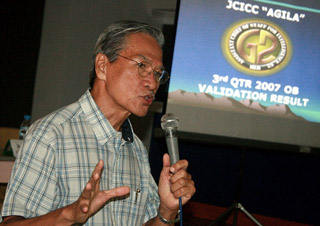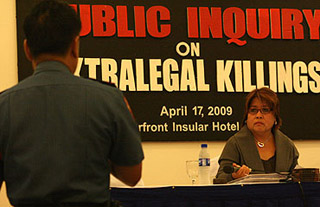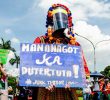(second of three parts)
First Part : A Pattern to Madness
By GERMELINA A. LACORTE
Davao Today
The mine-rich jungle of Compostela Valley is not only known for its gold. It�s also where the fight between the government troops and the Communist guerillas is at its fiercest. On its website, the military meticulously tallies their winnings in the battle in this part of Mindanao, just as the NPA lists down their victories.

Bayan Muna Partylist Representative Satur Ocampo presents the document containing names of progressive organization in the military’s order of battle. (davaotoday.com photo by Barry Ohaylan)
In his Davao visit in April this year, Defense Secretary Gilberto Teodoro described Compostela Valley, as �difficult,� as far as the government’s war against insurgents is concerned. This was the reason why the government has been concentrating troop deployment in the area. This Mindanews report revealed that Compostela Valley has already surpassed Bicol as government�s counter insurgency priority.
But what has the increased military operations in Compostela Valley got to do with the killing of activists in the region?
In Compostela Valley, where poverty condition is at its worst, most of the people earn a living either as workers of banana plantations or as farmers, explained Kelly Delgado, secretary-general of the human rights group Karapatan. Peasant groups and unions are very strong there, he said. �But these are �legal organizations� that the military consider as �infrastructures� for the insurgency,� Delgado said. �They want to demoralize the members by getting at their leaders.�
He said that as Communist rebels scale up attacks on government installations, the military gets back by attacking the progressive groups. �These are their easiest targets because they’re unarmed and they’re out in the open,� Delgado said.

Commission on Human Rights chairperson Leila De Lima during the April probe on extralegal killings in Davao City this year. (davaotoday.com photo by Barry Ohaylan)
When officials start issuing public statements branding them as Communists and linking them with the armed movement waged by the NPA, leaders of militant groups usually take these statements as warrant for their deaths. At the height of military operations which led to the evacuation of hundreds of peasants in Compostela Valley in the early part of 2008, statements from top military officials tagged the Kilusang Magbubukid ng Pilipinas (KMP)�where Pojas belonged�and numerous other groups, as �Communist fronts.�
But Major General Reynaldo Mapagu, the commanding officer of the Philippine Army’s 10th Infantry Division, denied it ever was a policy of the state to engage in the killings of activists. �We always tell our soldiers to observe discipline,� Mapagu said.
�We tell them, let�s not give people ammunition to hit us,� he said. Mapagu had replaced Jogy Leo Fojas as the 10th Infantry Division in February this year after a stint as commanding officer of `the Scout Rangers, the Philippine Army’s special anti-guerilla unit.
Colonel Oscar Lactao, chief of Task Force Davao, also said that �legal organizations� are part of the rebel group’s �united front,� hence, they�re directly linked with the Communist organization. But he denied it’s the military’s policy to target activists for summary killing. �We should identify who are directly linked with the underground organization and then file appropriate charges against them,� said Lactao.
Yet in May this year, Bayan Muna Partylist Rep. Satur Ocampo disclosed to the media a powerpoint presentation linking over a hundred individuals and progressive groups to the Communist movement. The document, dated third quarter of 2007, contained photographs of identified activist leaders and names of over a hundred organizations. The report identified the individuals and groups on the list as part of the NPA�s �white area� operation, an �indispensable strategy� in waging a �revolutionary struggle because it serves as well spring of support� for the �red area.� The report also stated that the white area prepares for the take over of the �red area,� and that the Communist party�s allied groups act as �shields� to the party�s �revolutionary struggle.�
The document caused a stir among progressive groups because it seemed to confirm what they�ve already suspected: that progressive groups have been targeted as part of the military�s strategy to wipe out the Communist insurgency by 2010.
Extrajudicial Killings









